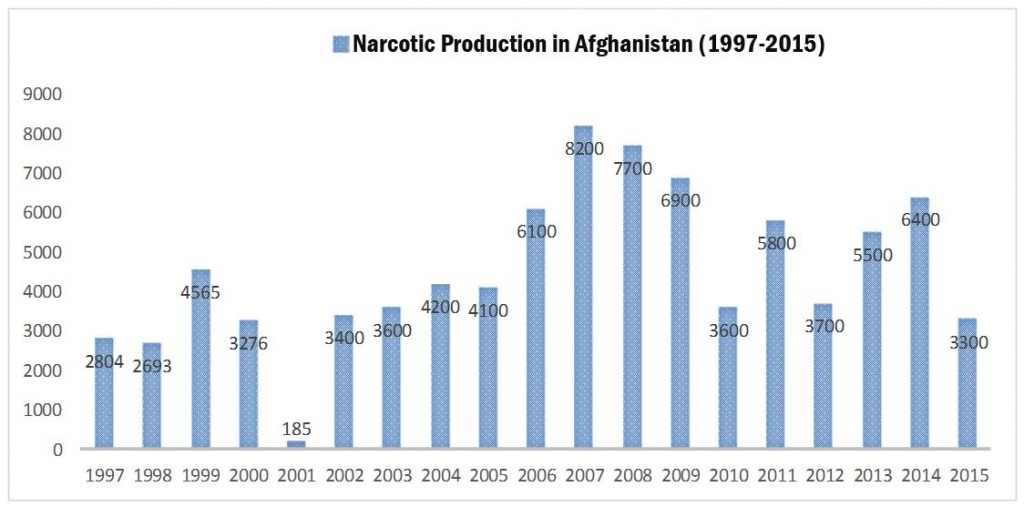Although in 1394, the cultivation and production of narcotics were decreased in Afghanistan; but it is still the largest producer of drugs in the world.
Although the Afghan government claims that it has had achievements in its fight against narcotics; but despite financial support of the international community, this struggle has not reached any noteworthy conclusion. According to the Afghan Ministry of Counter Narcotics, in 1394, they have seized 311 tons of drugs and arrested 2906 drug smugglers. Among them there were 10 international smugglers and also two outstanding international drug smugglers that US, Afghanistan and some other countries were after them for years.
According to Ministry of Counter Narcotics, the total income receives from Afghan Opium are estimated to be near $70 billion, and the income share is mostly divided between armed groups and Mafia.
Narcotic is a main problem in Afghanistan; on the one hand, it has defamed the country and on the other hand, according to the various reports there are 1 to 3 million drug addict in Afghanistan which is really an alarming challenge.
What are the reasons behind decrease in poppy cultivation and production last year? And what has the Afghan government done to tackle narcotics? These are the questions which will be analyzed here.
Cultivation and Production of Narcotics in Afghanistan
Cultivation of narcotics has a long history in Afghanistan and is an old tradition in the country. Narcotics were also being cultivated in Afghanistan during the cold war but there is no precise statistics about the amount of it.
Also after the cold war and during civil war, Afghanistan was among the countries that produced large amount of narcotics. In 1997, 2804 tons of drugs were produced in Afghanistan, this number reached 4565 tons in 1999; but in 2001, according to the decree of Taliban leader Mullah Mohammad Omar the production of narcotics decreased in Afghanistan and reached to 185 tons.
From 2002 to 2007, the production of narcotics was increasing annually, and reached from 3400 tons to 8200 tons. The main reason behind the rise in the production of narcotics was unprecedented cultivation of narcotics around the country. In 2002, around 74 thousand hectares of lands were used for cultivation of narcotics but in 2007 this number became increased to 193 thousand hectares.
But from 2007 to 2010, the production of narcotics decreased from 8200 to 3600 tons. But in 2011, 2012, 2013 and 2014, this number increased once again. From 2009 to 2014 the cultivation of narcotics increased in Afghanistan. In 2009, overall 123 thousand hectares of lands were used for narcotic cultivation in Afghanistan but in 2014, this number increased to 224 thousand hectares. (See graph-1)
Graph-1: narcotic production in Afghanistan (ton)
The Situation of Opium Production in 2015
In 2015, for the first time the amount of land used for cultivation of narcotics decreased. According to the United Nations Office on Drugs and Crimes (UNODC), in 2015, 183000 hectares of land was used to cultivate narcotics in Afghanistan which shows 19% decrease compared to 2014.
And also the production of narcotics was 3300 tons in 2015, which show a 48% decrease compared to 2014. Generally, narcotics were cultivated in insecure areas particularly in Helmand, Farah, Kandahar and Badghis.
Last year only in 14 provinces there was no cultivation of narcotics, but in remaining 20 provinces people had vastly cultivated narcotics. The reduction of narcotic cultivation was not due to the efforts of the NUG, but as a survey by UN shows, the main reason was bad weather.
The Afghan government’s policy to tackle narcotics
After the overthrow of the Taliban regime in Afghanistan, the formation of a ministry under the name of Ministry of Counter Narcotics was announced in Bonn Conference. In 1383, the Afghan president, Hamid Karzai announced that the fight against narcotics is the priority of his government, and the cultivation, production and smuggling narcotics was also banned. Besides that, cooperation between Ministries of Counter Narcotics, Interior, Public Health and Agriculture Irrigation and livestock and the UNODC was increased to tackle narcotics in the country.
Later, Ministry of Counter Narcotics announced a strategy to tackle Narcotics. The followings were the main point of this strategy:
- Taking necessary measures against drug smuggling
- Improving economic condition of the people
- Decreasing demand for drugs and treating drug addicts
- Improving governmental administration in provinces and districts
- Increasing public awareness, attracting regional and international cooperation, destruction of poppy corps, implementation of the law and spreading the alternatives of opium
both leaders of the NUG had persisted on fight against narcotic during their election campaign; but in this regard they have done nothing except destroying some poppy corps and arresting a small number of drug smugglers; and maybe the main reason behind that is insecurity in the country, because the government was focused on security and was not able to prioritize fight against narcotics.
Counter narcotic strategy
After overthrow of the Taliban regime, governmental and international strategies were unable to tackle narcotics in Afghanistan; the main reason behind it was the presence of foreign troops in the country and the people affiliated with it, and the involvement of government officials and their relatives in drug smuggling.
On the other hand, improper implementation of the law, involvement of the government’s armed oppositions in cultivation and production of narcotics in insecure areas, lack of alternatives and vast insecurity in the country were other factors that affected struggle against narcotics in Afghanistan.
Hence, approving counter narcotic laws will not eradicate it unless these laws are implemented, corruption is tackled, security is maintained, and alternatives are found.
The end


